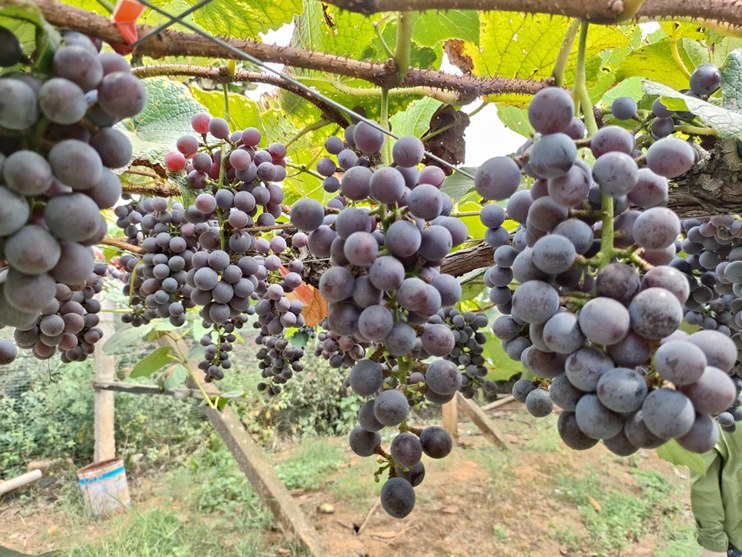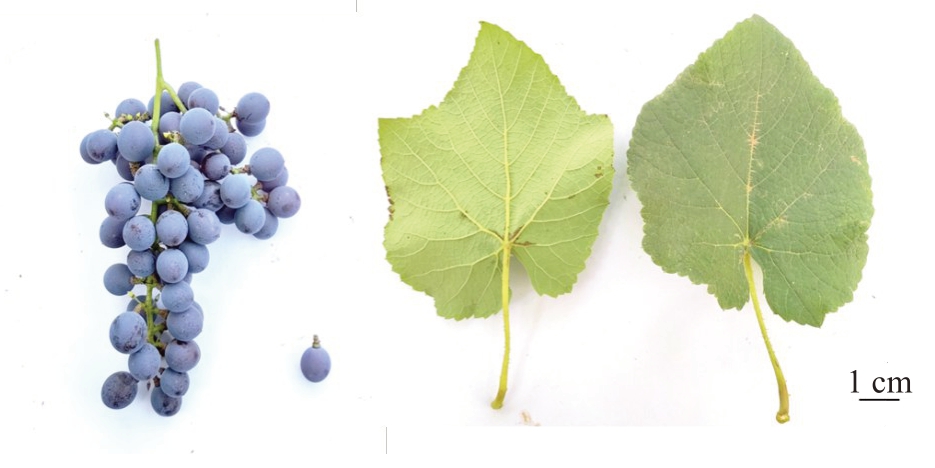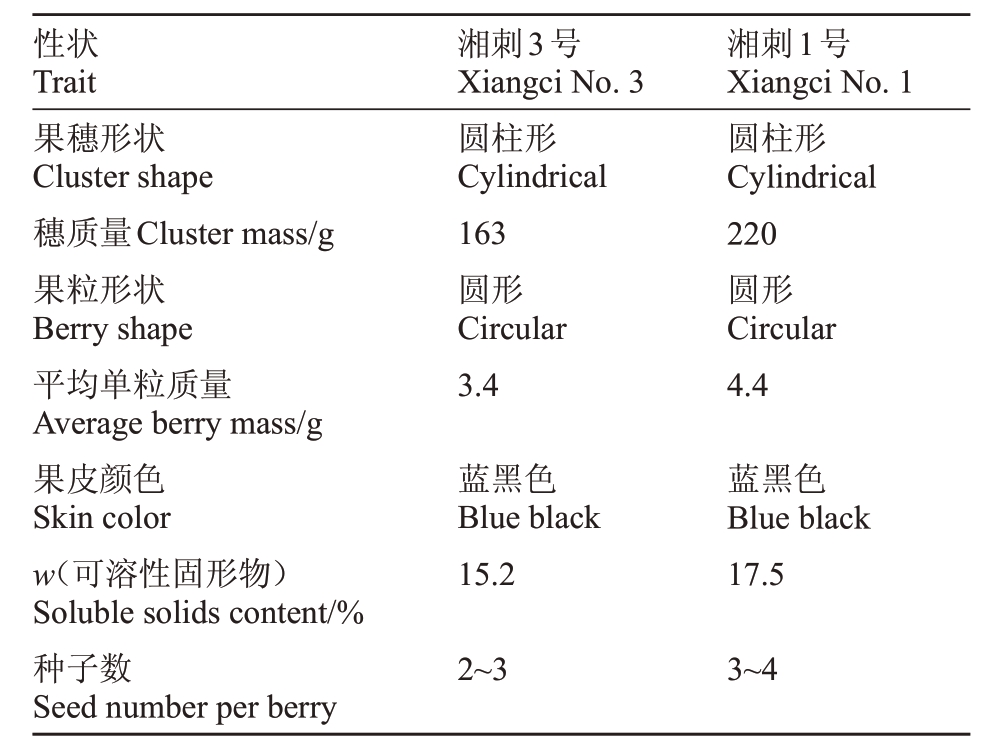刺葡萄(Vitis davidii Foёx.)属于葡萄科葡萄属东亚种群的一个种,为未完全经过人工驯化的野生植物资源,原产于湖南、云南、广东、江西、浙江等省[1]。在中国野生葡萄中刺葡萄的果粒最大,鲜食及加工兼用,具有一定的商业价值,其对黑痘病、白腐病、炭疽病等具有很强的抗性,成为葡萄耐湿热、抗病育种的宝贵资源[2]。湖南省选育的刺葡萄品种有紫秋[3]、湘酿1号[4]、湘刺1号[5]三个品种,成熟期均在9 月上旬,但仍有许多野生或变异资源未得到充分的保存和利用。
湘刺3号是湖南农业大学葡萄团队选育的刺葡萄新品种。果实成熟期晚(9月下旬)、糖酸比高,色素含量偏低,风味独特,营养及保健成分丰富,经试验研究其可鲜食亦适合制汁,并可用于酿制桃红或甜红葡萄酒。
1 选育过程
笔者课题组自2010 年开始对怀化市中方县桐木镇的实生刺葡萄类型进行调查和筛选,发现一个优良单株——湘刺3号(也称米刺葡萄)。该树树龄20 a(年)左右,定植行株距为6 m×6 m左右,采用棚架式栽培,棚架高2 m左右。自2012年开始对这株表现优异的刺葡萄进行植物学观测。并通过嫁接和扦插扩繁,从而得到优良株系,并在湖南农业大学及中方县进行区试和推广种植。2014—2015 年与湘酿1 号和另外几个刺葡萄类型进行了配组试验,该品种表现出成熟期晚于湘酿1 号和紫秋等品种。该株系果穗整齐,品质佳,果粒小,种子少,产量高,适应性及抗逆性强,更适合制汁和酿酒。2020 年6月19 日通过农业农村部非主要农作物品种登记,定名湘刺3 号[编号:GPD 葡萄(2020)430010](图1)。

图1 新品种湘刺3 号田间栽培表现
Fig.1 The new cultivar Xiangci No.3 and its field performance
2 主要性状
2.1 植物学特征
湘刺3 号属东亚种群刺葡萄种,两性花。该品种当年生枝及其叶柄部位着生皮刺(图2),幼叶鲜红棕色,成熟叶片为楔形;叶中等厚,锯齿多为两侧凸,数目少;叶柄洼多为开张,V 形。第一花序着生节位3~5节位,花序具副穗,5月上旬开花。冬季枝条黄褐色,横截面为椭圆形;皮刺中等密,较细(图3)。

图2 湘刺3 号枝梢皮刺着生
Fig.2 The state of prickles on the growing shoots of Xiangci No.3

图3 湘刺3 号成熟果穗和叶片
Fig.3 Mature cluster(left)and leaves(right)of Xiangci No.3
2.2 果实经济性状
湘刺3 号果穗多为圆柱形(表1),松紧适中;平均单穗质量163 g,果粒圆形,单粒质量3.4 g;果粉薄,果皮较厚;初始着色为红紫色,成熟后为蓝黑色。含种子2~3 粒,多为3 粒,种子黑褐色,无外表横沟,种脐明显;平均百粒质量3.16 g,长5.02 mm,宽3.97 mm,与紫秋相比种子短小,长宽比小。
表1 湘刺3 号和湘刺1 号主要果实性状比较
Table 1 The comparison of main fruit attributes between Xiangci No.3 and Xiangci No.1

性状Trait果穗形状Cluster shape穗质量Cluster mass/g果粒形状Berry shape平均单粒质量Average berry mass/g果皮颜色Skin color w(可溶性固形物)Soluble solids content/%种子数Seed number per berry湘刺3号Xiangci No.3圆柱形Cylindrical 163圆形Circular 3.4湘刺1号Xiangci No.1圆柱形Cylindrical 220圆形Circular 4.4蓝黑色Blue black 15.2蓝黑色Blue black 17.5 2~3 3~4
2.3 生物学特性
2.3.1 物候期 在湖南,湘刺3号一般于3月下旬至4月初萌芽,4月下旬至5月上旬开花,9月中下旬果实成熟。从萌芽到成熟约170 d,从坐果到成熟约130 d,属极晚熟品种。
2.3.2 结果性能 湘刺3号的丰产稳产性强。一般栽后第2 年开始结果,每666.7 m2产量500~750 kg,第3 年每666.7 m2平均产量750~1000 kg。果枝着生于结果母枝第2~10 节,每果枝平均结2 穗果实,单穗质量最大可达250 g。
2.3.3 抗逆性与适应性 湘刺3 号抗逆性较好,抗旱性强,极抗多湿土壤。田间种植病害较少,对葡萄黑痘病、葡萄白粉病、葡萄炭疽病、葡萄灰霉病等病害的抗性极强,对葡萄霜霉病抗性较差。抗虫性强,适宜栽培于湖南省各地。
3 遗传特异性
利用9 对SSR 标记检测了刺葡萄新品种湘刺3号的遗传特异性。9 对标记分别为VChr3a[6]、VVMD5[7]、VrZAG79[8]、VrZAG62[8]、VVMD28[9]、VVMD27[8]、VChr14b[6]、VVMD7[7]、VVMD25[9]。结合其他品种在这9 个位点的基因型数据,计算出个体间的遗传距离,使用遗传距离数据构建聚类图,结果表明该品种在遗传上是特异的,不同于其他供试刺葡萄和鲜食葡萄品种。刺葡萄新品种湘刺3号与其他刺葡萄品种或株系(包括湘刺1号、E8_7、E15_4等)聚为一类;鲜食葡萄品种(如金手指、玫瑰香、红宝石无核、红地球等)聚为一类,酿酒葡萄黑比诺单独聚为一类。在刺葡萄品种或株系一类中,湘刺3号与湘刺1 号有分离,该品种与特异单株E8_7 及E15_4和E14_9的关系要近于湘刺1号(图4)。

图4 湘刺3 号与其他刺葡萄和鲜食葡萄品种的关系聚类分析
Fig.4 The genetic relationship between other spine and table grape cultivars and Xiangci No.3
遗传距离Nei’s genetic distance
4 栽培技术要点
4.1 架式与整形
湘刺3 号宜采用平棚架式栽培,栽植密度为4 m×5 m,采用单干 “H” 形或多主蔓棚架整形。也可采用 “双十字V形架” 结合避雨棚栽培方式,以防霜霉病危害,株行距宜2 m×3 m。
4.2 肥水管理
为满足葡萄各个生育期对养分的需求,采用有机肥和无机肥配合施用,在保障底肥使用充足有机肥的前提下,减少化肥的用量。有机肥充足可改善土壤团粒结构,减少果实的生理病害,提高果实品质。施肥量依目标产量和土壤而定。刺葡萄丰产性好,种植户常会追求高产,施肥时需要注重对土壤的改良和对根系的养护。在根系生长高峰期之前适当使用氨基酸、腐殖酸等肥料,促进根系的生长。
4.3 花果管理
该品种丰产性好,在栽培中应注重对产量进行控制。可以通过疏除过多花穗而定产。在露地栽培条件下,湘刺3号果穗松紧适中,但其果粒相对于鲜食葡萄较小,因此一般不必对单穗疏果。萌芽后应抹芽疏枝,花期以前需疏除过密枝梢,保证通风透光,减少灰霉病的发生概率。在果实发育期适当留副梢,以便在果实采收后仍可制造部分养分用于来年生长。
4.4 病虫害防治
病虫害以农业防治为主,宜采用生物防治,注重冬季清园,消灭越冬病虫源。选用国家允许的杀虫剂与杀菌剂防治,农业与化学综合防治,防治效果好,确保生产出来的葡萄鲜果符合无公害果品的要求。在花期适当防治灰霉病,在全生长季重点防治霜霉病,在着色后期即小大暑期间注意防治炭疽病。
5 不同地区栽培条件下的果实品质
5.1 果实品质总体表现
湘刺3 号在各试点均表现果实商品性好,果穗松紧适中,果实含糖量高,酸度低,品质好,平均可溶性固形物含量为15.2%,最大值可达16%,加工性能好(表2)。
表2 不同地区栽培条件下湘刺3 号果实品质总体表现
Table 2 The overall performance of fruit quality of Xiangci No.3 under cultivation conditions in different regions

地区Region怀化芷江Zhijiang,Huaihua怀化中方Zhongfang,Huaihua澧县Lixian长沙Changsha吉首Jishou平均穗质量Average cluster mass/g 165平均粒质量Average berry mass/g 4.0 w(总酸)Total acid content/%0.36 w(可溶性固形物)Soluble solids content/%16.0 163 3.0 0.29 15.2 170 159 157 4.1 3.2 2.9 0.34 0.19 0.22 15.4 13.9 15.4
5.2 栽培建议
笔者课题组自2010 年开始对怀化市中方县桐木镇的刺葡萄类型进行调查和筛选,选出优良单株。历经5 a的研究,已明确湘刺3号的生长结果习性及高效无公害栽培配套技术。研究结果表明,湘刺3号对土壤要求不严,适应性强,完全可以在湖南省及其他南方各省栽培。在生产实践中,选择地势高、排水良好的地块建园,采用深沟高垄棚架栽培;生长季节注意疏花疏果与疏枝,秋季严格控制副梢生长;重施有机肥,防止因土壤贫瘠缺铁造成黄化。
[1] 石雪晖,杨国顺,熊兴耀,刘昆玉,钟晓红,王先荣,倪建军,郭光银.湖南省刺葡萄种质资源的研究与利用[J].湖南农业科学,2010(19):1-4.SHⅠXuehui,YANG Guoshun,XⅠONG Xingyao,LⅠU Kunyu,ZHONG Xiaohong,WANG Xianrong,NⅠJianjun,GUO Guangyin. Research and utilization status quo of germplasm resources of Vitis davidii Foёx in Hunan[J]. Hunan Agricultural Sciences,2010(19):1-4.
[2] 陈婷,刘鑫铭,蔡盛华,雷龑.刺葡萄种质资源研究进展[J].中国农学通报,2017,33(1):52-56.CHEN Ting,LⅠU Xinming,CAⅠShenghua,LEⅠYan. Germplasm resources of Vitis davidii:Research advances[J]. Chinese Agricultural Science Bulletin,2017,33(1):52-56.
[3] 熊兴耀,王仁才,孙武积,李枝清,欧阳建文,李桂永,刘东波.葡萄新品种‘紫秋’[J].园艺学报,2006,33(5):1165.XⅠONG Xingyao,WANG Rencai,SUN Wuji,LⅠ Zhiqing,OUYANG Jianwen,LⅠGuiyong,LⅠU Dongbo. A new cultivar of Vitis davidii‘Ziqiu’[J]. Acta Horticulturae Sinica,2006,33(5):1165.
[4] 莫银屏,徐丰,石雪晖,杨国顺,刘昆玉,金燕,钟晓红.湘酿1号刺葡萄离体快繁技术试验[J].中外葡萄与葡萄酒,2015(2):26-28.MO Yinping,XU Feng,SHⅠXuehui,YANG Guoshun,LⅠU Kunyu,JⅠN Yan,ZHONG Xiaohong. Rapid propagation technology of Xiangniang-1 (Vitis davidii Foёx.) in vitro[J]. Sino-Overseas Grapevine&Wine,2015(2):26-28.
[5] 杨梅,潘永杰,杨国顺,石雪晖,刘昆玉,白描,罗飞雄.刺葡萄新品种湘刺1 号的选育[J].果树学报,2023,40(9):2001-2005.YANG Mei,PAN Yongjie,YANG Guoshun,SHⅠXuehui,LⅠU Kunyu,BAⅠMiao,LUO Feixiong. A new spine grape cultivar Xiangci No. 1 (Vitis davidii Foёx.)[J]. Journal of Fruit Science,2023,40(9):2001-2005.
[6] BOWERS J E,DANGL G S,VⅠGNANⅠR,MEREDⅠTH C P.Ⅰsolation and characterization of new polymorphic simple sequence repeat loci in grape(Vitis vinifera L.)[J].Genome,1996,39(4):628-633.
[7] SEFC K M,REGNER F,TURETSCHEK E,GLÖSSL J,STEⅠNKELLNER H. Ⅰdentification of microsatellite sequences in Vitis riparia and their applicability for genotyping of different Vitis species[J].Genome,1999,42(3):367-373.
[8] BOWERS J E,DANGL G S,MEREDⅠTH C P. Development and characterization of additional microsatellite DNA markers for grape[J].American Journal of Enology and Viticulture,1999,50(3):243-246.
[9] CⅠPRⅠANⅠG,MARRAZZO M T,DⅠGASPERO G,PFEⅠFFER A,MORGANTE M,TESTOLⅠN R.A set of microsatellite markers with long core repeat optimized for grape (Vitis spp.) genotyping[J].BMC Plant Biology,2008,8:127.